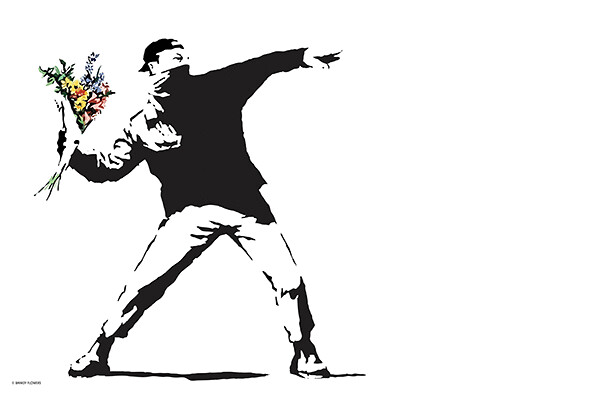Banksy, one of the world’s most notorious street artists, has learned a hard lesson about trademarks. Trademarks is a type of intellectual property (“IP”) that protects things such as brand names and logos. The British artist recently lost a court battle in which the trademark for his popular Flower Thrower image was declared invalid. However, Banksy’s contempt for copyright, which protects artistic expressions such as his graffiti art, and other IP is well documented. Why then did he seek to trademark the Flower Thrower image in the first place? And why was the trademark found invalid? It is all tied to Banksy’s desire keep his identity a secret.

Banksy Makes a Mark
While his true identity is not publicly known, Banksy is a British graffiti artist who rose to infamy in the 1990s. He is known for creating satirical, and often politically charged, murals across the globe. The image at issue in this case, also known as Love is in The Air, was originally painted on the side of a garage in Jerusalem in 2005. It depicts a young man, understood to be a protester, throwing a bouquet of flowers. This and all other works believed to be attributed to Banksy are authenticated by Banksy’s company, Pest Control Office Ltd.
The notoriously anonymous artist had successfully applied to trademark the image in the European Union (“EU”) in 2014. A trademark dispute was initiated in 2019 by the UK-based greeting card company, Full Colour Black Ltd. The company, which sells products featuring Banksy’s work, sought cancellation of the mark. This was in response to the artist’s attempt to limit their unauthorized merchandising of his work. Banksy lost the suit after a three-judge panel ruled that the artist was merely attempting to circumvent IP laws. How so? This requires a bit more understanding of both trademark and copyright law.
Crafty Maneuvers Paint a Bad Picture
US law protects trademarks used in commerce with or without federal registration. A federal registration requires filing an application with the United States Patent and Trademark Office (“USPTO”). However, in the EU, trademarks are required to be registered in order to receive protection. This means that the EU must review and approve an application before the mark is considered valid. Once a valid trademark exists, the owner has rights to prevent others from using it on goods or services in commerce.
Copyright, on the other hand, is a type of IP that provides owners with several rights related to creative works of art. These include the exclusive rights to reproduce the work or make it public for a limited duration of time. In both the EU and the US, copyright protects a work for 70 years after the artist’s death. Types of work that are eligible for copyright protection include books, movies, music, pictures, paintings, sculptures, and many others. A copyright exists in both the US and EU as soon as a work is created. So, for example, as soon as you put brush to canvas and create an image with adequate expression for copyright law purposes, it is a valid copyright. In other words, no government registration is required.
Why then did Banksy seek trademark protection in the EU instead of, or in addition to, relying on his automatic rights as the owner of a valid copyright? It all comes down to Banksy’s desire to hide his identity. In the EU, copyrights belong to the individual who made the work. This means Banksy would have to disclose his identity to sue for copyright infringement. But trademarks are a different story. A trademark can be owned by either an individual or an entity. In this case, the trademark was issued to Pest Control Office. This allowed the company to sue for trademark infringement while preserving Banksy’s anonymity.
But what exactly is wrong with asserting trademark rights in this case? EU trademark law requires owners to meet certain conditions to maintain their trademark registration. Conditions that, according to the court, Banksy and Pest Control Office sought to meet through insincere means.
Use It or Lose It
The overarching purpose of trademark law is to allow consumers to distinguish the source of goods or services. So, for example, when consumers see a “swoosh” on pair of sneakers, they know that the shoes come from Nike. In order to receive federal trademark registration, US law requires actual “use in commerce” (or a bona fide intent to use) to ensure this purpose is satisfied from the moment of registration. On the other hand, the EU has no requirement that an applicant demonstrate use in commerce in order to secure registration. However, an EU trademark must be used in commerce within the first five years of registration. If not, it can be removed for the register due to non-use. Trademark owners who fail to maintain legitimate use of the mark as a source identifier may be subject to cancellation of their mark.
Full Colour Black requested cancellation of the “Flower Thrower” mark on the grounds that Banksy had not made commercial use of it as required by EU law. The company asserted that Banksy only applied for the mark to prevent use of his work, rather than on legitimate trademark grounds as a source identifier. Following the advice of his legal team, Banksy set up a brick and mortar shop called Gross Domestic Product. The shop only offered online sales of Banksy’s own merchandise in an attempt to demonstrate use of his marks in commerce as required by EU law. Banksy credited the trademark dispute as the motivating factor behind the actions, acknowledging that it was “possibly the least poetic reason to ever make some art.”
This did little to convince the court of the mark’s validity, and the advice of Banksy’s legal team backfired. In its decision, the court was critical of the shop, asserting that its creation was “inconsistent with honest practices.” The panel determined that the store was only opened to overcome non-use of the mark, rather than as a legitimate intent to commercialize any goods. The court resolved that the trademark was filed in bad faith and declared its registration invalid.
The Art of the Matter
Many of the trademarks in Banksy’s portfolio face the same issue as his Flower Thrower image. Meaning this ruling may threaten Banksy’s global empire and put the artist’s other marks at risk. While the decision seems to be in line with global trademark principles, it ultimately limits some artists’ remedies for unauthorized use of their work throughout the EU. Those that want their identity to remain private will be forced to decide between anonymity and protection of their artistic works. For artists like Banksy, this is not only a matter of preserving their artistic reputation, but a concern for their legal protection. Graffiti art is illegal in many parts of the world. This puts artists at risk of being convicted for crimes such as destruction of property. This means that the monetary value of these art works may continue to be exploited by everyone but the artists that create them.

Lydia Bayley
Associate Blogger
Loyola University Chicago School of Law, J.D. 2022
